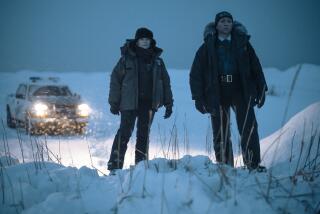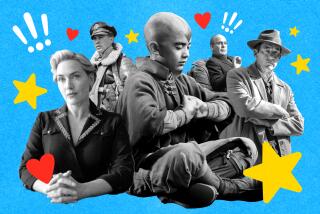‘Twin Peaks’ and turning television into a genuine art form
“Twin Peaks” returns to television Sunday, again written by co-creators Mark Frost and David Lynch, with Lynch directing and many cast members back in place. Two episodes of the Showtime revival will also screen at the Cannes Film Festival, because TV isn’t just television anymore.
The original “Twin Peaks” had the hallmarks of what journalists have taken to calling prestige television. It looked good, and, more important, it had a look, the rich, saturated American-roadside glamour Lynch earlier brought to his film “Blue Velvet.” Not a frame of film or a note on the soundtrack seemed less than intentional. It was the work of a successful film director, and at a time when television — it aired on ABC — was considered a secondary medium, somewhere to escape from the movies.
The notion that TV is in some sort of Diamond-Studded Platinum age has been commonplace for some time, and it is true that good television has never seemed so varied or overwhelmingly abundant. But many of the best-regarded modern series are just elevated versions of what television has always done — produce well-written, beautifully acted, intelligent, moving but generally familiar stories of crime or love or work, occasionally turned a shade darker for gravitas.
“Twin Peaks,” on the other hand, was something else: It was weird. Part lacerating comedy, part farcical drama, it played with conventions of television, without looking or acting quite like anything that had ever been seen there. It intensified but didn’t parody the emotions and intimacies of what was then the only sort of serial TV — soap operas, daytime and prime-time. It was provocative not for the sake of being provocative but as the upshot of an unusual aesthetic sensibility and worldview expressing itself in a context in which it would not normally be found.
All across the history of television, such oddities have occurred — comedies, dramas, cartoons — that seem both surprising and inevitable, that share an air of having to have been made, whatever the likelihood of success, which seems to qualify them as art. (That isn’t to say “arty,” as when a show merely urges its style upon you.) These are the programs that make television exciting to me — the unexpected, the inexplicable, the uncompromising series that make me wonder: “How did that get here?”
It’s the thrill I felt, for instance, when I encountered Thu Tran’s “Food Party,” a surrealist, cardboard-and-glitter puppet-and-people show. Perhaps my favorite series while it aired on IFC in 2009 and 2010, it was made by former art students whose work had been discovered on the Web, where many unaccountable things happen. In one episode, Tran gives birth to a pie containing a live kitten that will later kill her other puppet children, who are discovered to be full of cherry compote and candy-severed thumbs, and then blast off into space.
And it’s how I felt years before, as an impressionable young person confronted with “The Prisoner,” Patrick McGoohan’s 1967 quasi-sequel to the series “Secret Agent,” in which a nameless spy, having angrily resigned his post, wakes up trapped in a baroque seaside prison cum holiday camp. McGoohan had something he wanted to say about authority and resistance, conformity and individuality, and the fact that “The Prisoner” managed only a single 17-episode season, which ended with a deep dive into absurdity, was not a shock and nothing to mourn. “The Prisoner” was not made to run forever; or perhaps better put, it was made not to run forever.
Or take “Freaks and Geeks,” another commercial failure turned cult classic, thanks to most everyone in it becoming famous later. From its unfashionably cool color palette to its dismissal of the sort of easy-to-read “victories” the network would have been all too happy to have, “Freaks and Geeks” went its own way, finding humor in existential crises but never pushing into the usual streams of high school farce. Watching it now, it still seems utterly singular in its look and pacing; not even producer Judd Apatow’s next TV series “Undeclared” followed its lead.
What makes such oddities possible? Luck sometimes — the rogue programming executive who just wants to see something made. Success in another medium might do it — “Pee-Wee’s Playhouse,” a cheeky multimedia art project in the form of a children’s show, followed on the theatrical success of “Pee-Wee’s Big Adventure.” Or an earlier success in television — if “Deadwood” hadn’t been so well-regarded, David Milch could never have made “John From Cincinnati,” a semi-mystical spiritual surf epic created with novelist Kem Nunn. It was officially a flop but I’m happy it was made.
Louis CK’s “Louie” lavished the sort of careful attention on its look and sound that has become standard in more recent cable comedies. Influenced by European art-house and American underground cinema, CK found a way to shape art films of shorter and longer length into one of TV’s most ambitious comedies. His “Horace & Pete,” a cycle of performed-live plays in the form of a television series, was a project so unlikely he didn’t even bother to pitch to a network but put up for sale, episode by episode, on his website.
Much of this action takes place at the fringes of the medium, on smaller cable stations or in off-hours, where riskiness can be more than its own reward, failure is less expensive and relatively few people are watching. “Space Ghost Coast to Coast,” in which footage from a 1960s superhero cartoon was repurposed into a 1990s talk show, with live-action guests, was Cartoon Network’s first real series. It crept into view at 11 on Friday nights and its mix of the fantastic and the banal set the style for the network’s “Adult Swim” block.
Children’s shows, and things that look like children’s shows, are often allowed an extra measure of strangeness — you can’t really explain the Teletubbies — in part because they’re not perceived as being important. That’s wrong: “The Adventures of Pete & Pete,” a 1990s Nickelodeon series ostensibly for young people, made use of some of independent filmmaker Hal Hartley’s crew and cast members to create a mythic and mysterious vision of suburban childhood and was as good as anything TV has produced. I’d say as much of Cartoon Network’s “Adventure Time,” another mythic, mysterious and unusually tender show, whose characters have (rare for a cartoon) aged over its run and grown more complex. Like “Twin Peaks,” it is full of death and transfiguration.
Watching old episodes of ”Twin Peaks” now, I find that, even after nearly three decades, they have not lost their power to disturb, disorient and enchant. Was it art? (And will it be art when it returns?) “Art” is a loaded, imprecise word; we often use it to dignify what we like, to mean “This is better than great.” But one is tempted to reach for it when nothing else seems to fit, when shows go where they need to go, out of bounds, into the new, and carry us along.
Follow Robert Lloyd on Twitter @LATimesTVLloyd
ALSO
Gleaning the clues from David Lynch’s hilariously cryptic ‘Twin Peaks’ panel
‘Adventure Time’ sets the series finale, but you still have time
Enjoying the strange tastes at Thu Tran’s ‘Food Party’ on IFC
Patrick McGoohan was No. 1 as ‘Prisoner’s’ Number 6
More to Read
The complete guide to home viewing
Get Screen Gab for everything about the TV shows and streaming movies everyone’s talking about.
You may occasionally receive promotional content from the Los Angeles Times.







